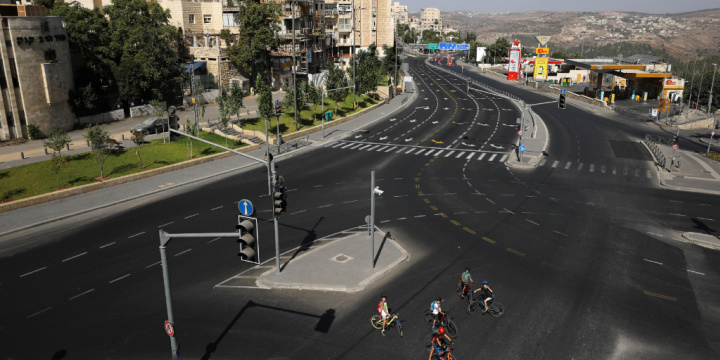A Yom Kippur Guide for the Perplexed
 by Yoram Ettinger
by Yoram Ettinger

Children ride bicycles on an empty street, on Yom Kippur, in Jerusalem, Israel, Sept. 28, 2020. Photo: Reuters / Ammar Awad.
Here are 10 facts about the upcoming holiday of Yom Kippur:
1. Yom Kippur is observed on the 10th day of the Jewish month of Tishrei, concluding 10 days of soul-searching and spiritual self-awareness and self-enhancement, which begins on Rosh Hashanah, the first day of the Jewish year. According to Leviticus 23:26-32: “The Lord said to Moses, that the tenth day of this seventh month [Tishrei] is the Day of Atonement. … Do not do any work on that day. … This is a lasting ordinance for generations to come….”
Yom Kippur commemorates the day of divine forgiveness for the sin of worshiping the golden calf idol. It is a warning against a recurring human fallibility: the temptation to sacrifice spiritual values on the altar of materialism.
2. The astrological sign of Tishrei is Libra, which symbolizes the scales of justice, truth, optimism, humility, and tolerance.
3. The Hebrew word Kippur [כיפור] means atonement and repentance — a derivative of the Biblical word Kaporet [כפורת], which was the dome/cover of the Holy Ark in the Sanctuary, and the word Kopher [כופר], which was the cover/dome of Noah’s Ark and the Holy Altar in the Jerusalem Temple.
4. Asking forgiveness of fellow human-beings is a major feature of Yom Kippur, transferring human behavior from acrimony and vindictiveness to forgiveness and peaceful coexistence. It is consistent with the philosophy of Hillel the Elder, a leading 1st century BCE Jewish sage: “The essence of the Torah is: do not do unto your fellow person that which is hateful to you; the rest [of the Torah] is commentary.”
5. Yom Kippur highlights magnanimity, humility, genuine-repentance, compassion, consideration, forgiveness, responsibility, optimism, and faith. It recognizes one’s fallibility, emphasizes learning from one’s mistakes, minimizing future missteps, elevating morality, and enhancing family and community cohesion. Criminals and sinners are invited to participate in Yom Kippur services.
6. Fasting is a key feature of Yom Kippur, reducing material pleasure in order to focus on one’s soul-searching, and enhancing empathy with the needy. The Hebrew spelling of fasting [צומ] is the root of the Hebrew word [צמצומ] for reducing/focusing. However, Judaism opposes asceticism and self-torment, and therefore views genuine repentance as a critical engine of elevating individuals from despair to hope.
8. Yom Kippur is concluded by blowing the Shofar, which represents a moral wake-up call. The blowing of the Shofar commemorates the saving of Isaac; the receipt of the (second) Ten Commandments at Mount Sinai; the re-entry to the Land of Israel and the conquest of Jericho by Joshua; and Gideon’s victory over the much larger Midianite military.
9. The Biblical scroll of Jonah is read on Yom Kippur, underscoring the four universal pillars of Yom Kippur: repentance, prayer/faith, justice, and forgiveness. The Prophet Jonah (“dove” in Hebrew), son of Amitay (“truth” in Hebrew), sailed to a faraway land and transformed a sinful society into a pious society, thus, displaying social responsibility.
10. A memorial candle in memory of one’s parent(s) is lit on Yom Kippur, reaffirming “Honor thy father and mother,” and providing an opportunity to ask forgiveness of one’s parent(s).
The author is a writer and former Israeli ambassador.
 Ilhan Omar Silent After Daughter’s Arrest, Suspension for Role in Columbia University Anti-Israel Protest
Ilhan Omar Silent After Daughter’s Arrest, Suspension for Role in Columbia University Anti-Israel Protest Cultural Center Backed by Iran’s Revolutionary Guard Plans to Produce Films About Attack on Israel
Cultural Center Backed by Iran’s Revolutionary Guard Plans to Produce Films About Attack on Israel How Does Ilhan Omar Really Feel About Iran?
How Does Ilhan Omar Really Feel About Iran? This Passover, Combine Respect for Tradition with the Courage to Innovate
This Passover, Combine Respect for Tradition with the Courage to Innovate Israel’s Iran Attack Carefully Calibrated After Internal Splits, US Pressure
Israel’s Iran Attack Carefully Calibrated After Internal Splits, US Pressure Palestinian Cameramen Exposed in New Footage Documenting Oct. 7 Atrocities Side by Side with Terrorists
Palestinian Cameramen Exposed in New Footage Documenting Oct. 7 Atrocities Side by Side with Terrorists US Money to Convicted Terrorists; US Training to Aspiring Terrorists
US Money to Convicted Terrorists; US Training to Aspiring Terrorists Man Arrested in Paris After Iran Consulate Incident
Man Arrested in Paris After Iran Consulate Incident Amazon Pulls Book by Hamas Leader Yahya Sinwar Referencing Oct. 7 Attacks After UK Lawyers Intervene
Amazon Pulls Book by Hamas Leader Yahya Sinwar Referencing Oct. 7 Attacks After UK Lawyers Intervene Israeli Government Approves Increased Payments to Returned Gaza Hostages
Israeli Government Approves Increased Payments to Returned Gaza Hostages



 ‘A Time for Vigilance’: FBI Director Says Agency on Alert for Threats Against Jewish Community During Passover
‘A Time for Vigilance’: FBI Director Says Agency on Alert for Threats Against Jewish Community During Passover This Passover, Combine Respect for Tradition with the Courage to Innovate
This Passover, Combine Respect for Tradition with the Courage to Innovate ‘Crisis at Columbia’: Elite University Spirals Into Chaos Against Backdrop of School President’s DC Testimony
‘Crisis at Columbia’: Elite University Spirals Into Chaos Against Backdrop of School President’s DC Testimony How Does Ilhan Omar Really Feel About Iran?
How Does Ilhan Omar Really Feel About Iran? Jordan Reaffirms Commitment to Peace With Israel After Iran Attack, Says Ending Treaty Would Hurt Palestinians
Jordan Reaffirms Commitment to Peace With Israel After Iran Attack, Says Ending Treaty Would Hurt Palestinians